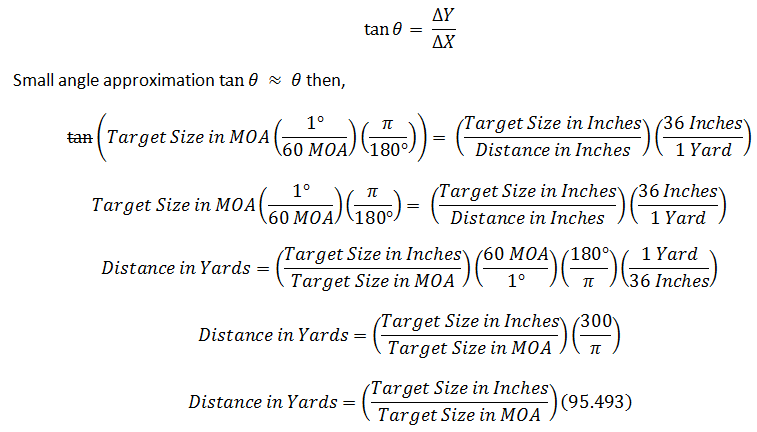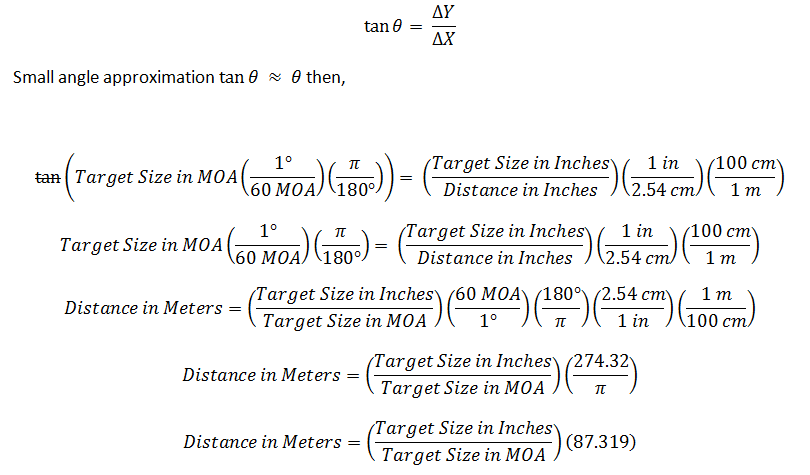Join the Hide community
Get access to live stream, lessons, the post exchange, and chat with other snipers.
Register
Download Gravity Ballistics
Get help to accurately calculate and scope your sniper rifle using real shooting data.

Install the app
How to install the app on iOS
Follow along with the video below to see how to install our site as a web app on your home screen.
Note: This feature may not be available in some browsers.
You are using an out of date browser. It may not display this or other websites correctly.
You should upgrade or use an alternative browser.
You should upgrade or use an alternative browser.
Rifle Scopes Ranging with MOA
- Thread starter davidky
- Start date
(target size/Image size)*87.3= range in meters
(target size/Image size)*95.5= range in yards
Or that's the way I understand it.
(target size/Image size)*95.5= range in yards
Or that's the way I understand it.
(target size/Image size)*87.3= range in meters
(target size/Image size)*95.5= range in yards
Or that's the way I understand it.
Agreed but keep in mind that depending on the magnification used the MOA reading will differ. For example 24x equals a true 2moa on my reticle whereas 16x equals 4moa. Your scope may very so be sure to check the literature included.
That's only if it's a second focal plane.
True. Good catch, I forgot that little tidbit there. Thanks for the addition.
This may be a simple question but I've never seen it addressed anywhere. Can you range with a MOA scope?
Yes.
IPHY really makes ranging simple. Estimated target size in inches / IPHY subtensions target displaces = distance in hundreds of yards. Example: 30" target / displaces 2 IPHY subtensions = 15 hundred yards, 30" target / displaces 2.5 IPHY subtensions = 12 hundred yards. Really easy math with the added bonus that you can probably be accurate enough in your target size estimation to hit with the first round.
It is no more retarded than mils. It's just math.MOA reticle? Yes, but it's a bit retarded.
Mrad formula
Ts/isX25.4=range (meters)
Ts/isX27.77 range (yards)
IPHY really makes ranging simple. Estimated target size in inches / IPHY subtensions target displaces = distance in hundreds of yards. Example: 30" target / displaces 2 IPHY subtensions = 15 hundred yards, 30" target / displaces 2.5 IPHY subtensions = 12 hundred yards. Really easy math with the added bonus that you can probably be accurate enough in your target size estimation to hit with the first round.
Yes it is easier to range, but iphy isn't measuring a true degree of a radius as mils and moa are. Not sure if this matters though as 10" would be 10" no matter what.
Yes it is easier to range, but iphy isn't measuring a true degree of a radius as mils and moa are. Not sure if this matters though as 10" would be 10" no matter what.
It surely is. You can think of it however you like, 1/3600th of a radian as opposed to 1/1000th. Minutes are 60ths of degrees, which is a circle divided into 360 equal parts. Of IPHY, mils, and MOA only MOA doesn't have a designed connection to the radius of said circle, which for our purposes equates to the distance to the target. The math will have to accommodate this fact and be a step more complex.
I've got a MOA scope and I plan on doing that. For longer ranges it would be good to have a quality range finder also.
For years I used a duplex reticle in a 3x9 Leupold scope. It was first focul plane, so I had to make sure it was on 9 power.
A deer sized critter would cover up exactly the distance between the heavy duplex crosshairs at 300 yards and half that distance at 500 yards, 3/4 the distance was 400 yards. I wouldn't shoot any further than that, because I don't like wounding game. This method wouldn't work very well beyond 500 yards. It wasn't perfect but it worked well for me. Jack O'connor used to size game up with a LEE dot. I know that there are better methods and systems these days.
Military snipers often do the same thing, usually with mil dots. There's no reason you can't do the same thing with a good MOA scope. For me MOA are easier to figure. IF you have been trained with mil dots maybe that is the easiest.
I don't mean to sound like a know it all. I'm sure others can probably give you a better answer, but this is my two cents worth.
For years I used a duplex reticle in a 3x9 Leupold scope. It was first focul plane, so I had to make sure it was on 9 power.
A deer sized critter would cover up exactly the distance between the heavy duplex crosshairs at 300 yards and half that distance at 500 yards, 3/4 the distance was 400 yards. I wouldn't shoot any further than that, because I don't like wounding game. This method wouldn't work very well beyond 500 yards. It wasn't perfect but it worked well for me. Jack O'connor used to size game up with a LEE dot. I know that there are better methods and systems these days.
Military snipers often do the same thing, usually with mil dots. There's no reason you can't do the same thing with a good MOA scope. For me MOA are easier to figure. IF you have been trained with mil dots maybe that is the easiest.
I don't mean to sound like a know it all. I'm sure others can probably give you a better answer, but this is my two cents worth.
IPHY really makes ranging simple. Estimated target size in inches / IPHY subtensions target displaces = distance in hundreds of yards. Example: 30" target / displaces 2 IPHY subtensions = 15 hundred yards, 30" target / displaces 2.5 IPHY subtensions = 12 hundred yards. Really easy math with the added bonus that you can probably be accurate enough in your target size estimation to hit with the first round.
In the real world the easy example numbers never usually work. All the math should be done with something that will be accurate as possible and not in your head.
To the original question, yes you can. You can also use a mildot master to make life easier. Use the numbers on the right under MOA and then look to the left side for the range.
This may be a simple question but I've never seen it addressed anywhere. Can you range with a MOA scope?
Absolutely, whether milliradians or minutes of angle it's just an angular measurement.
(target size/Image size)*87.3= range in meters
(target size/Image size)*95.5= range in yards
Or that's the way I understand it.
Your correct.
Here's the derivation in yards:

Here's the derivation in meters:

Yeah, you might have to break out a calculator or a pen and paper if the target is 11" and covers 1.25 IPHY, but the real crux in getting accurate quotients is estimating the targets size in the first place.In the real world the easy example numbers never usually work. All the math should be done with something that will be accurate as possible and not in your head.
To the original question, yes you can. You can also use a mildot master to make life easier. Use the numbers on the right under MOA and then look to the left side for the range.
In any case you can range with MOA. Estimate your target size in inches, divide by the number MOA subtensions your target displaces, and then multiply by 95.5 (which is the number of yds where the MOA angle subtends one inch) as was mentioned earlier.
Similar threads
- Replies
- 3
- Views
- 392
- Replies
- 1
- Views
- 182
- Replies
- 53
- Views
- 2K
